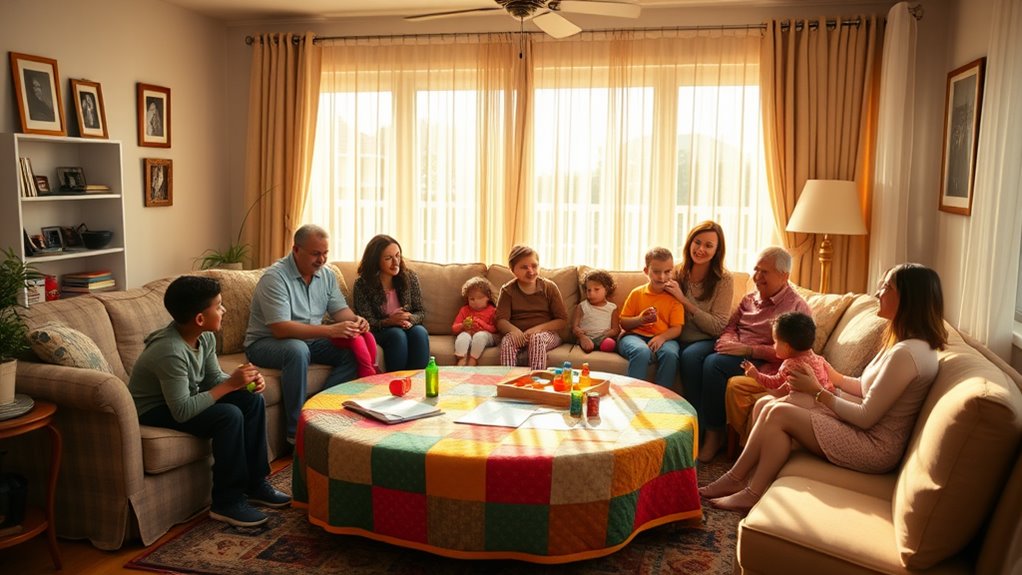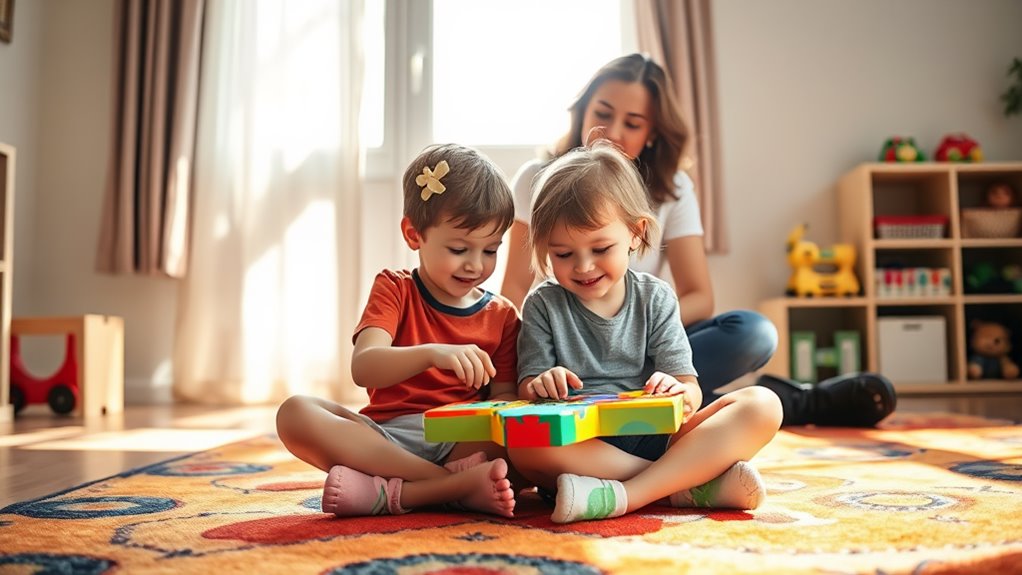5 Essential Tips for Navigating Blended Family Dynamics!
Navigating blended family dynamics isn’t always easy, but a few essential tips can help. Start by establishing clear boundaries with your partner and involve the kids in the conversation. Foster open communication through regular family meetings, allowing everyone to express themselves. Manage expectations realistically; building bonds takes time. Be patient during adjustment periods, as each family member copes differently. Lastly, maintain consistent parenting approaches to create a supportive environment. Remember, every step you take strengthens your family unit, and there’s even more to explore about fostering harmony in blended families.
Establish Clear Boundaries
Setting clear boundaries is crucial in blended families to foster healthy relationships and reduce conflicts. You need to define what’s acceptable and what isn’t, both for yourself and the children involved. Start by discussing boundaries with your partner. Agree on rules regarding discipline, household chores, and personal space. This unified front helps everyone understand expectations.
Next, involve the kids. Sit down together and outline boundaries that respect everyone’s feelings. Encourage them to voice their thoughts; it’ll make them feel valued and heard. Be sure to clarify how these boundaries apply to each family member, including step-siblings and biological children.
Consistency is key. Once you’ve established boundaries, stick to them. If someone crosses a line, address it immediately. This ensures everyone knows the consequences of their actions. Remember, boundaries aren’t about control; they’re about creating a safe and respectful environment for everyone.
Lastly, be flexible when necessary. Life changes, and so might the boundaries. Regular check-ins can help you reassess and adjust them as needed. By setting clear boundaries, you’re laying the groundwork for a harmonious blended family life.
Foster Open Communication
Open communication is the cornerstone of a successful blended family. When you encourage everyone to express their thoughts and feelings openly, you create an environment where trust can flourish. Start by making it clear that everyone’s opinions matter. Schedule regular family meetings where everyone can voice their concerns and share their experiences. This helps to ensure that no one feels left out or unheard.
Don’t shy away from difficult conversations. If tensions arise, address them promptly and constructively. Use “I” statements to describe feelings rather than placing blame, which can lead to defensiveness. For example, say, “I feel upset when…” instead of “You make me upset when…” This approach fosters understanding rather than conflict.
Encourage your kids to communicate openly with each other, too. Teach them the importance of listening as much as speaking. By modeling good communication habits, you set a positive example for them to follow.
Lastly, be approachable. Let your family know they can come to you with anything. When everyone feels safe to share, you’ll strengthen your family bond and navigate blended family dynamics more smoothly.
Manage Expectations Realistically
Managing expectations realistically is crucial in a blended family, as it helps prevent misunderstandings and disappointment. You might have visions of harmony and instant bonding, but it’s important to remember that building relationships takes time and effort.
Establishing clear expectations can create a more supportive environment. Use the table below to guide your thinking:
| Expectation | Reality |
|---|---|
| Everyone will get along right away | It takes time to build connections |
| Kids will accept new family members without issue | Children may struggle with change |
| You’ll have a perfect family dynamic | Conflicts and challenges are normal |
| Holidays will be stress-free | There may be competing traditions |
| Communication will be easy | Open dialogue requires practice |
Respect Adjustment Periods
Adjustment periods are an essential part of blending families, and respecting them can lead to healthier relationships. When you bring together different family dynamics, it’s normal for everyone to need time to adjust. You might find that children from both sides react differently to the new family structure. Some may embrace it, while others could feel overwhelmed or resistant.
To help ease this transition, acknowledge that feelings of uncertainty or discomfort are valid. Encourage open communication among family members, allowing everyone to express their thoughts and emotions. You might create a safe space for discussions, so no one feels isolated during this time.
It’s also important to be patient. Change doesn’t happen overnight, and rushing the process can lead to frustration. Set realistic timelines, understanding that each person’s adjustment pace may vary. Respect each individual’s journey, whether they’re adapting quickly or taking their time.
Maintain Consistent Parenting Approaches
As family members start to settle into their new roles, maintaining consistent parenting approaches becomes vital for harmony. When you and your partner establish clear expectations, it helps create a unified front that children can rely on. Consistency builds trust and makes it easier for kids to understand boundaries, which is essential in a blended family.
Start by discussing your parenting styles openly. Share your values, discipline methods, and communication preferences. This dialogue will help you identify areas where you agree and where adjustments might be necessary. Make it a priority to align your approach to rules and consequences. If one parent says no to a request, the other should support that decision, even if they feel differently.
Additionally, involve the kids in this process. Encourage them to express their feelings about the rules. This inclusion can foster respect for the parenting structure you establish. Remember, it’s okay to adapt as needed, but aim to keep core values consistent. By working together and being transparent, you’ll create an environment where everyone feels secure, understood, and supported, ultimately strengthening your blended family bond.
Frequently Asked Questions
How Can I Help Children Bond in a Blended Family?
To help children bond in a blended family, encourage shared activities, foster open communication, and promote teamwork. Celebrate each child’s individuality while creating a supportive environment where they feel safe expressing their thoughts and emotions.
What Role Should Stepparents Take in Discipline?
Stepparents should support the primary parent’s discipline approach while establishing their own guidelines. You’ll need to communicate openly, ensuring consistency and respect. Building a positive relationship helps children understand your role and authority within the family.
How Can I Address Loyalty Conflicts Among Children?
To address loyalty conflicts among children, you’ll want to encourage open communication. Create a safe space where they can express feelings, reassure them that love isn’t divided, and remind them it’s okay to have different allegiances.
What Activities Promote Unity in a Blended Family?
To promote unity in a blended family, you can organize game nights, go on family outings, or cook together. These activities encourage communication and bonding, helping everyone feel included and valued within the family unit.
How Do We Celebrate Holidays With Two Families?
To celebrate holidays with two families, you can alternate celebrations, create joint traditions, or host combined gatherings. Make sure everyone feels included and respected, and focus on building shared memories to strengthen family bonds.





